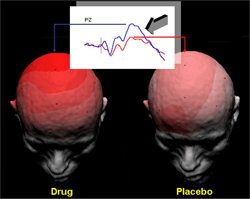Exploring new pathways to language
Temple research finds an ADHD drug could help individuals with aphasia regain language abilities.
| When ABC journalist Bob Woodruff was injured while reporting in Iraq in 2006, he suffered severe head injuries that caused him to lose his ability to recall and produce common words — a condition called aphasia. Today, Woodruff has recovered most of his language skills thanks to intensive behavioral therapy — reading and repeating words and sounds.
“The standard of care for patients with aphasia has always been and will always be speech/language therapy, but a new area is opening up that looks at what drugs can be used in combination with therapy to enhance recovery from brain damage and help the brain repair itself,” said Gerry Stefanatos, D.Phil., an associate professor of communication sciences and disorders in the College of Health Professions. “We’re looking at the mechanism of how this combination works — it’s underlying effect on patients with aphasia.” |
 Art courtesy Gerry Stefanatos
While most aphasia patients benefit from behavioral therapy to regain their language skills, a new area of treatment is opening up which looks at certain drugs to help augment the therapy. Temple’s Gerry Stefanatos presented research this month which found that a medication commonly prescribed for ADHD can help process speech in the brain. The blue trace (above) represents brain electrical activity in response to speech during therapy while on the medication.
|
|
suffering from Broca’s aphasia and the similar Anomic aphasia. “Improving a patient’s attention and working memory may allow them to better focus and process information during therapy sessions,” said Stefanatos. “Attention is critically important for learning and relearning skills, and could be helpful in forging new neural pathways in the brain.” The National Aphasia Association estimates some one million people in the United States live with aphasia, which is caused by lesions to the language centers of the brain. These lesions are often due to stroke or brain injury, but can also be the result of a brain tumor or progressive disease such as Parkinson’s or Alzheimer’s. Types of aphasia can range from a patient having difficulty finding and producing a word to a patient having no ability at all to speak or understand language. Stefanatos’ study looked at the use of D-AMPH in ten aphasia patients. All were also given a placebo for comparison purposes. In each condition, participants were asked to make decisions about different types of speech sounds (vowels, consonant-vowels) and complex tones. Their brain’s electrical response to each was recorded via an electroencephalogram (EEG). Those who took the D-AMPH had a strong reaction to the sounds — even to consonant-vowel sounds, which are more often difficult for individuals with aphasia to process. “This tells us that D-AMPH may help the left hemisphere of the brain regain the ability to perform its functions,” said Stefanatos. “Understanding why the drug is having this effect allows us to start to think about how to tailor treatments to make them more effective or explore alternative drugs or drug combinations.” Stefanatos said he and his team chose to look at this particular drug because in patients with ADHD it has been shown to stimulate the release of dopamine and epinephrine, which help in attention and learning. But he notes that some people aren’t good candidates for this particular drug. “Now that we have a rudimentary understanding of why the drug may work to enhance the results of therapy, our next step is to look at dose effects and perhaps other drugs with more favorable side effect profiles,” said Stefanatos. With collaborators from the departments of Radiology and Physical Medicine and Rehabilitation, Stefanatos will next study functional magnetic resonance imaging to explore the effects of D-AMPH on cerebral metabolism and where in the brain of individuals with aphasia it has the greatest effect. Other authors on this study are Andrew DeMarco at Temple University, Robert Segal at McGill University in Quebec, and Arthur Gershoff, M.D. and Y. Ieuji of the Moss Rehab Stroke and Neurological Diseases Program, part of the Albert Einstein Healthcare Network in Philadelphia. This work was funded by grants from the National Institute of Health and the Pennsylvania Department of Health. |
|